
The Songs of lyrebirds sung to glaciers
by Penelope Cain
- View Penelope Cain's Biography
Penelope Cain is an artist-researcher working at the intersection of art-science and storytelling, based between Sydney and the Netherlands.
The Songs of lyrebirds sung to glaciers
Penelope Cain
We are contaminated by our encounters...
Anthropologist Anna Tsing.1
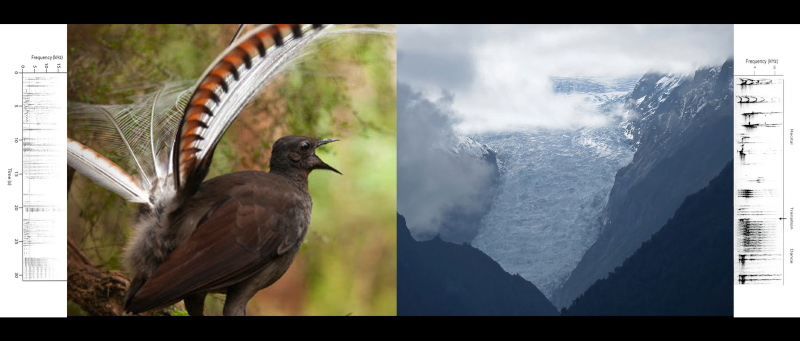
Image credit: Lyrebird and Tasman glacier image harvested from internet. Lyrebird sonics sourced from Dalziell, 2012.
The Balangara / Dyagula / Menura novaehollandiae / superb lyrebird sings the songs of many birds. Across the areas where superb lyrebirds are found, each valley is home to a lek,2 a group of up to a dozen male lyrebirds that come together to compete in the breeding season with song and display. Like any club of males, they sing and dance together, competing for female attention. Each lek has a colloquial song, a team song or a dialect they practice solo in the off-season and compete with, when breeding. Lyrebirds are excellent mimics, performing a sonic recollection of the forest around them; the birds they hear, see and smell. However, they do not necessarily mimic all the birds around them, acting more like 'unreliable' narrators of the bush.3 Like all good storytellers their sounds create worlds. Their mimicry skills are profound and research indicates that other bird species cannot tell the difference between lyrebird mimicry and the calls of their own species.4
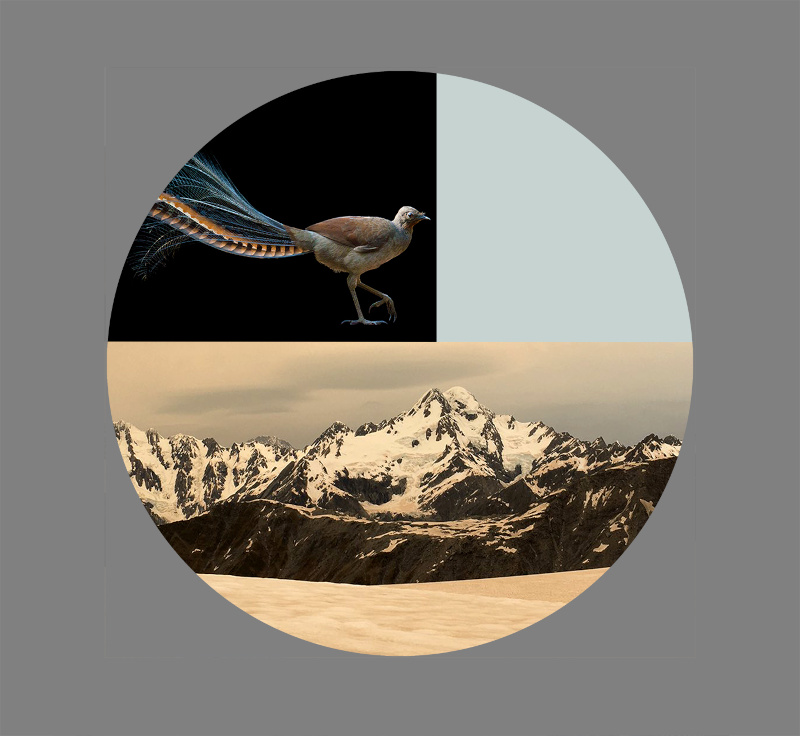
Image credit: Song and Ice, Penelope Cain 2021. Source image of Aoraki/Mount Cook range, Jan 2020, supplied by Dr John Hunt.
Audio credit: Lyrebird recordings, Blue Mountains.
In 2020, I mapped the post-fire lands of the Blue Mountains, on Gundungurra and Darug country, and the growth of the new anthropogenic, post-fire forest. Each month I returned to the same site, documenting the changes. In the first months after the fires the bush was silent.
Ants were the first to return, then smaller insect-eating birds. Months later, the forest had a few songs again. I met a lyrebird one winter morning, practicing its song while foraging alone amongst the once burned and regrowing trees, turning over the deep leaf-litter under the bushes for insects and grubs.
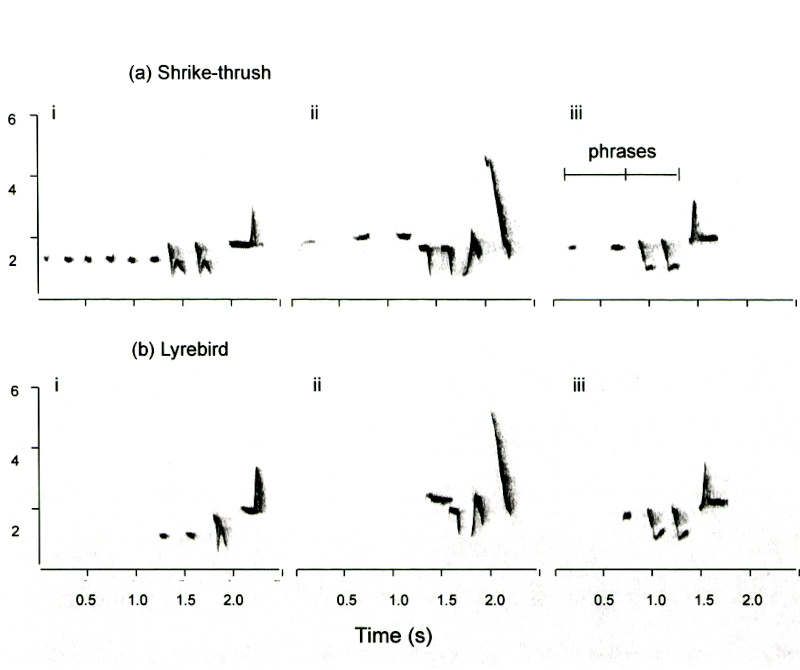
Image credit: Comparison of strike-thrush and Lyrebird mimicry. Anastasia H Dalziell, The ecology of vocal mimicry in the superb lyrebird, Menura novahollandiae, PhD Thesis, 2012. fig 3.1, p 75.
Long-lived, mating annually, the female lays one egg — a cryptic avian calculation for species survival. Lyrebirds live in temperate rainforest lands and 50% of lyrebirds along the east coast NSW were lost in the 2020 fires — either burned or subsequently starved.5 There is insufficient data to know how this impacted the lost leks and the sonic memories of the valleys that they held in their songs. After the rains I read that in the 2020 bushfires peak, dust and ash from east-coast fires blew across the Tasman Sea and covered the Southern Alps of New Zealand/ Kā Tiritiri o te Moana. The mountains were cloaked in a dreamlike dusky pinkish colour.
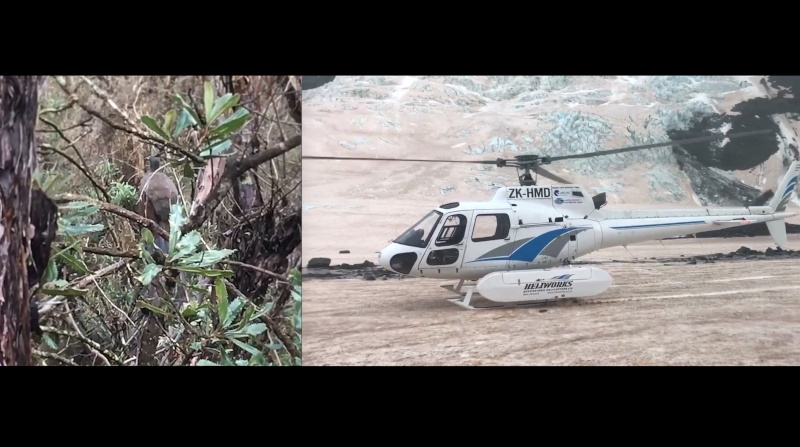
Image credit: Penelope Cain, still from video of found footage, 2022
Before the fires I had undertaken a line of research that told a transcontinental story about glaciers as atmospheric historians,6 so this new ice-bound connection between the burned forest of the lyrebirds across the ocean to New Zealand called for a new thread in the storytelling.
New Zealand glaciologists and climate researchers have started modelling the impact of future potential dust, fires and ash from hotter drier Australian summers on the already melting NZ glaciers.7 They speak in terms of whiteness; of 'albedo', which describes the reflective quality of snow and ice. Like a colourimetric indicator of entropy, it quantifies the decay in the pristine reflective new-snow appearance over subsequent days and weeks as atmospheric dust falls on it over time. Dust from the lands nearby and dust from other continents carried on upper atmospheric rivers of air.
There is an image that haunts; a satellite image of the entire NSW coastline shedding smoke in a brownish jet-stream over the Tasman. The smoke obliterates the view of the New Zealand South Island. Researchers calculated the ash of the black summer Australian fires (2020) covered 90% of the total glaciated area of the NZ South Island.8 The landscape of lyrebirds were brought, uninvited, to the glaciers of New Zealand. An ashfall in place of a snowfall, to darken the snow.
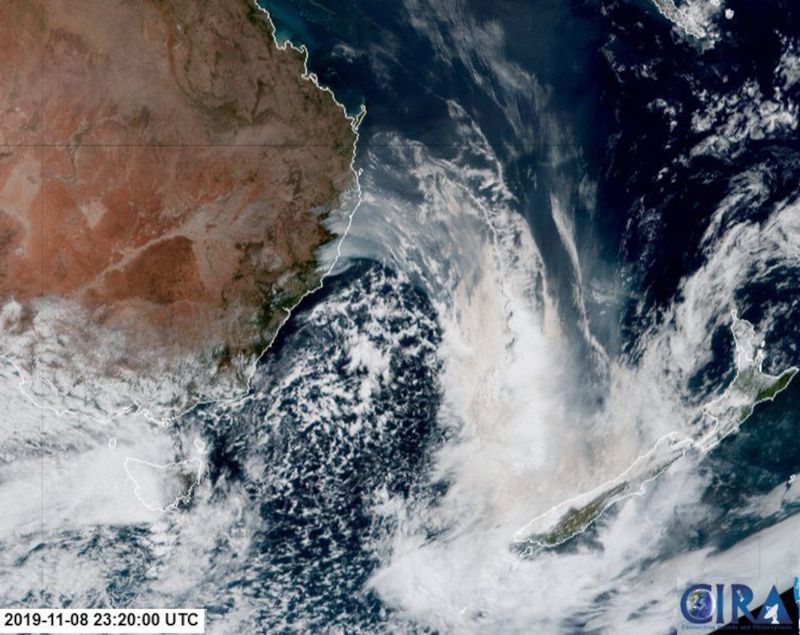
Image credit: Ash across the Tasman, sourced from NOA (National Oceanic and Atmospheric Administration) Jan 2021.
Glaciers sit on the edge of mountains, entirely at the grace of atmospheric temperatures. Glaciologists talk about firn lines and ablation zones, to describe the precarity of land-based glaciers, and to demark with almost-poetic terms the tipping point where melting losses exceed snowfall accumulation from higher up the glacier. These glaciers are like aquatic ghosts of the Pleistocene, as they follow deep-time ice-carved memories down the mountain. A frozen river formed from the weight of ice descending slowly; in fact, at a glacial pace — which is surely faster now than it used to be — to a glacial end point that is further up the mountain that ever before in the Holocene. Modelling indicates most glaciers in the world will be gone within 60 years and with them the histories of past atmospheres contained within their days, seasons and years of ice.9
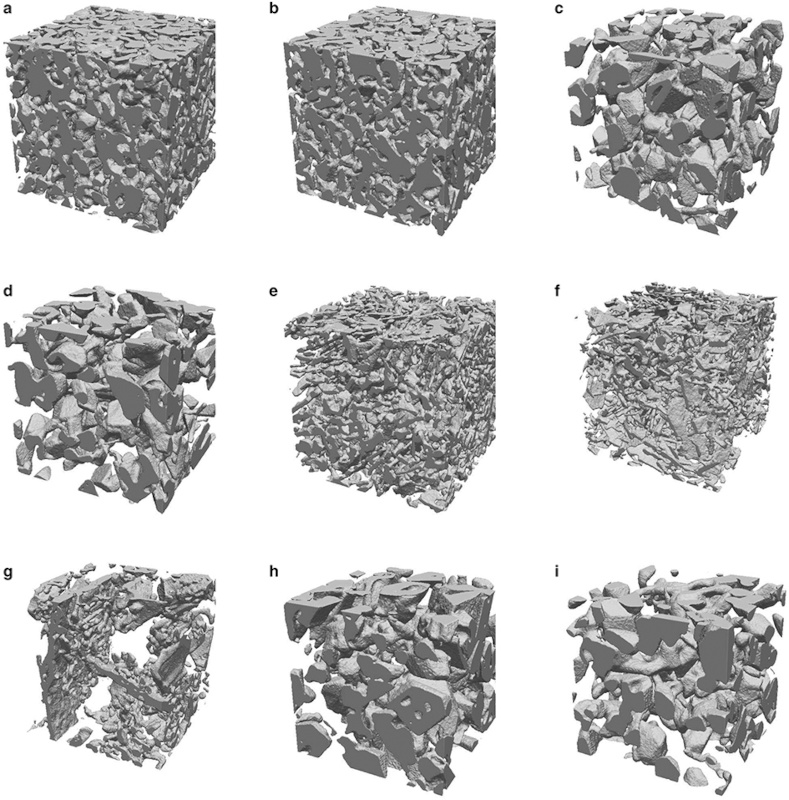
Image credit: Digitally collaged images originally sourced from Ebner et al, The Cryosphere, 9, 1363–1371, 2015
Audio credit: Glacier meltwater: Location unknown.
I scoured the internet, nagged contacts and searched for clips or recordings of lyrebirds from the Blue Mountains from before 2020. It felt necessary to archive those songs. The lyrebird experts did not have anything; limited funding precluded this as an area of high input research (if only lyrebirds dug for minerals instead of grubs, someone said). I eventually found a few clips and sent them to the New Zealand researchers collaborating with me on this project, along with a gopro; New Zealand was locked off pandemic-wise to everything apart from post. Finally, in February 2022 researchers from Victoria University, Wellington and Manaaki Whenua Landcare Research, Lincoln, set up camp on the saddle at the top of the Tasman Glacier/ Haupapa, along with my sound files and gopro. They were there to measure the impact of Australian dust on the snow albedo: like a form of post-carbon magic; the ability of burned forests to melt snow from a distance. They had visited the glacier to collect the fallen dust from the glacial snow two years earlier, in February 2020. It had only recently fallen and they worried that the dust would wash away, but felt strongly that it required further study. At the heart of every good scientist is a speculative artist.
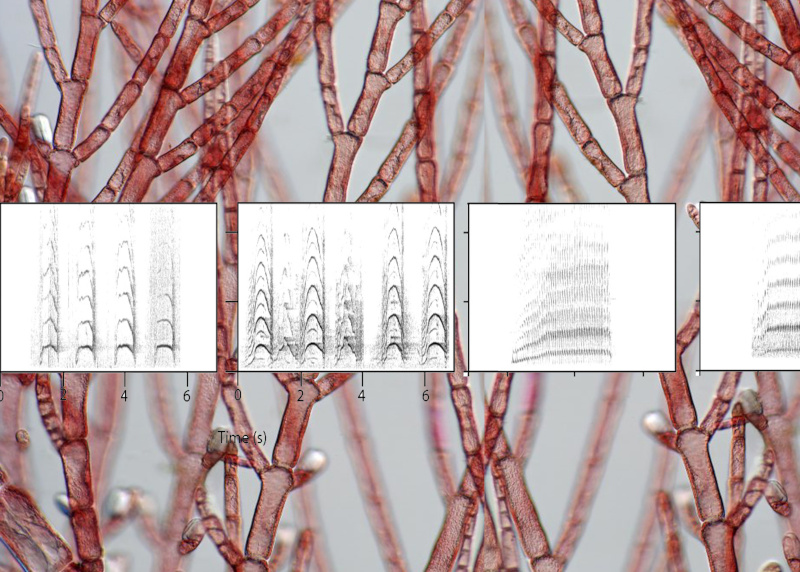
Image credit: Sonics study #3. Image of acoustic mapping of lyrebird sourced from Dalziell, 2012 - sound file: Lyrebird Mount Victoria 2013
Glacial snow is not just frozen water. It contains extremely hardy micro-organisms, living in, under and on the ice. Snow algae are one of these classes of extremophiles, existing in a sporulated senescence in the ice until they sense a slight increase in temperature from seasonal change, some spring from meltwater, or even from dust or ash increasing the surface temperature of the icepack by absorbing the sun's radiation. As they wake and replicate, they produce a red pigment, astaxanthin, which absorbs light across a wide spectrum and heats the snow around the algae, providing a tiny amount of meltwater for further algal replication — a colour-led micro-terraforming. Sometimes called watermelon snow, or pink snow, one of the researchers says it means that the last glacial ice on earth is predicted to be pink.
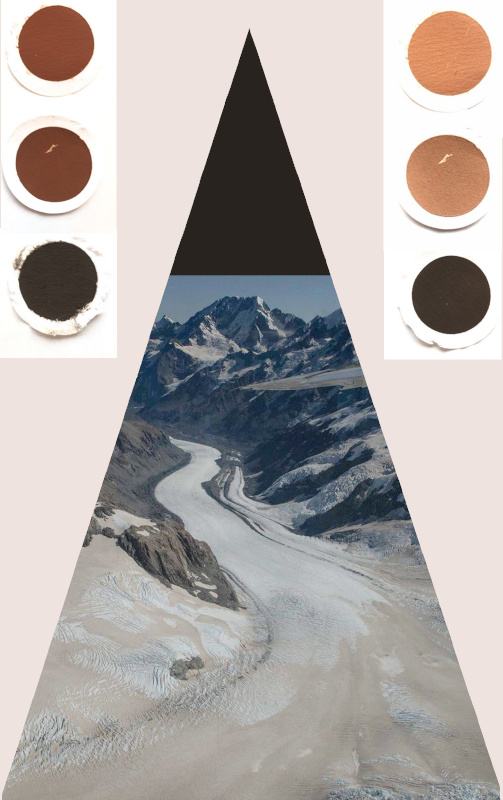
Image credit: Colourimetry of Carbon, Penelope Cain 2021. Image of Aoraki/Mount Cook range, Jan 2020, and images of colour disks modelled from ash colourimetry supplied by Dr John Hunt.
In their study, the researchers sprinkled titrated amounts of the Australian dust they had collected earlier onto demarked circular patches on the glacier and measured the resultant albedo and temperature changes in the snowpack. Almost like a colorimetric study — the additive impact of brown and pink — on melting snow. The data analysis is due later this year.
At the end of the study and before they packed up their equipment and tents, the researchers played the songs I had sent on their phone; the songs of lyrebirds were indirectly sung to the glacier. Their mimicry of Australian bush birds rolling from the mountain's peak, down the snow and rock valleys, followed by the unique laser gun-like sound that lyrebirds make and nobody can pinpoint. I wonder if lyrebirds make this peculiar sound as a shortcut to identifying each other in the bush, when every lyrebird sounds not like a lyrebird, but like any possible range of birds. To be continually sonically camouflaging can be a problem that requires an innovative avian acoustic solution.
And by way of avian reply, the researchers concluded by playing the sound of a Kea they had recorded, down the rocky valleys; the Kea calling back to the lyrebirds.
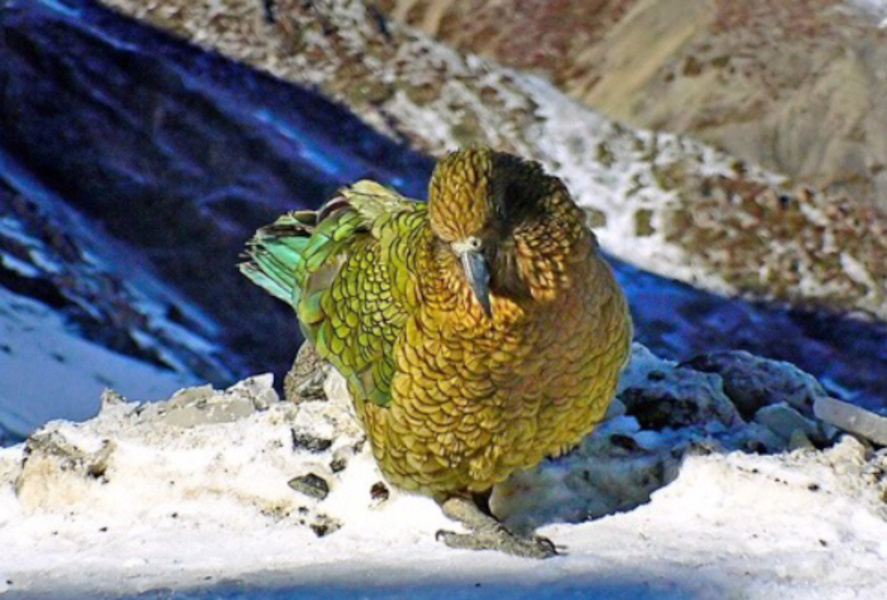
Image credit: Kea, courtesy by Bernard Spragg
Audio credit: Kea, Fox Glacier Township
This is the first song / chapter / line of research of in-progress work, that will ultimately end with a vocal work for three voices; lyrebird, glacier and snow algae.
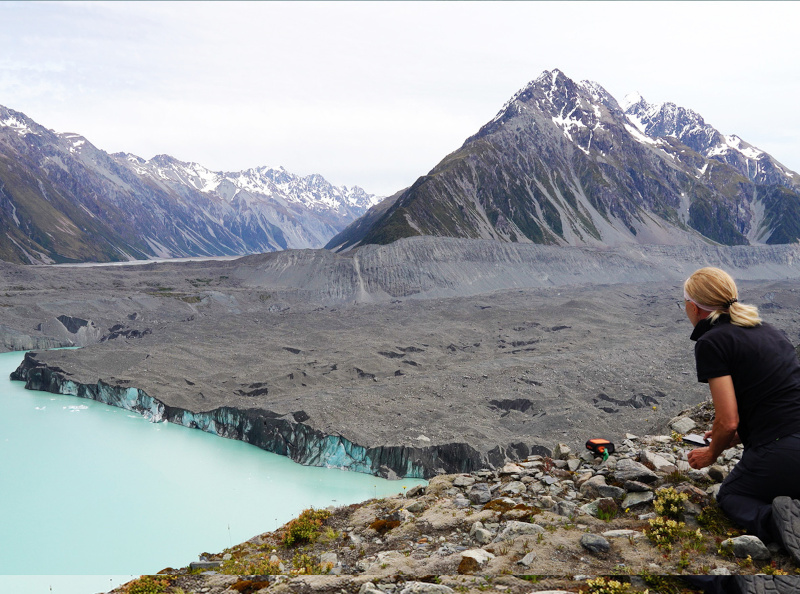
Image credit: Fieldwork in progress, playing lyrebirds songs to glaciers, Haupapa/Tasman Glacier. Penelope Cain, 2023.
With thanks to collaborators:
- Dr John Hunt
- Dr Phil Novis
- Manaaki Whenua-Landcare Research
Works cited
- Anna Lowenhaupt Tsing, The Mushroom at the End of the World: On the Possibility of Life in Capitalist Ruins, 2015. Princeton. ↩
- More accurately described by animal behaviouralists as 'lek-like.' ↩
- Term coined by Dr Anastasia Dalziel. ↩
- Anastasia H. Dalziell, Robert D. Magrath, 2012. Fooling the experts: accurate vocal mimicry in the song of the superb lyrebird, Menura novaehollandiae. Animal Behaviour* 83 (2012), pp. 1401-1410. ↩
- Birdlife Australia ↩
- Penelope Cain, Saturn's Breath (2019-ongoing) is a molecular level mapping of the outcome of mining silver for Australia's first local colonial coin, through to the Quelccaya glaciated icecap, Peru. As part of this a 3D render of the lifespan of Quelccaya through to 2080 is included, created with Dr Christian Yarlequé Instituto Nacional de Investigación en Glaciares Ecosistemas de Montaña INAIGEM, Peru. ↩
- Nicolas J. Cullen et al, 2017. An 11-year record of mass balance of Brewster Glacier, New Zealand, determined using a geostatistical approach. Journal of Glaciology (2017), 63(238) 199-217. ↩
- Wei Pu et al, 2021. Unprecedented snow darkening and melting in New Zealand due to 2019-2020 Australian wildfires. m5GeSdc; May 4, 2021; 15:15. ↩
- Dr Christian Yarlequé, personal dataset, Instituto Nacional de Investigación en Glaciares y Ecosistemas de Montaña INAIGEM, Peru. ↩

